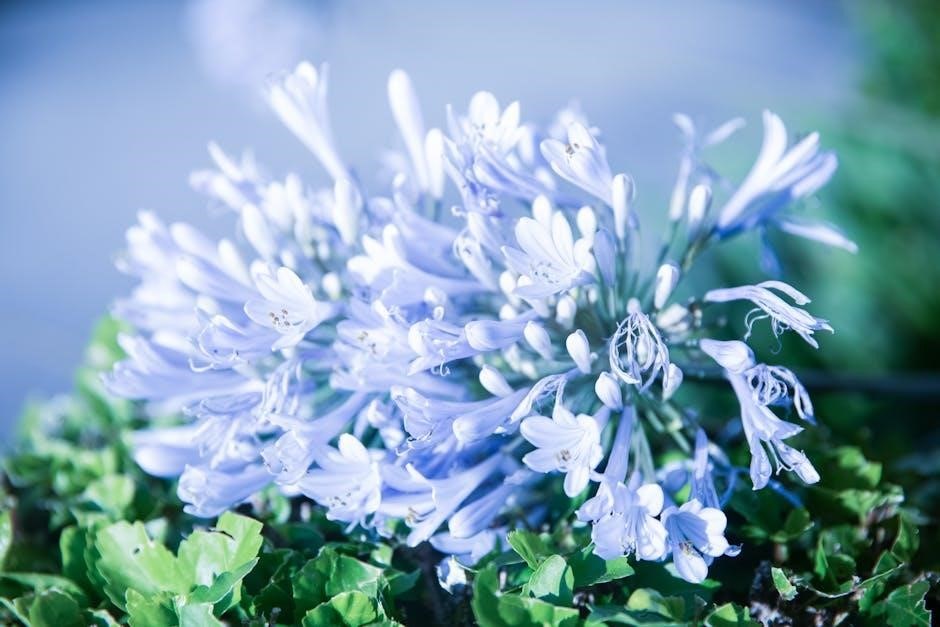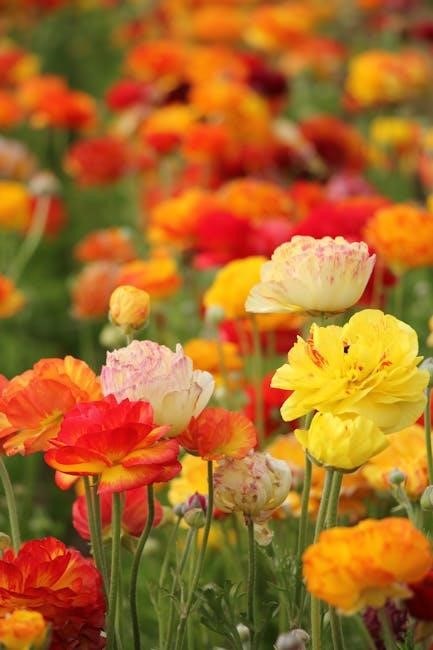California native gardening is a sustainable and eco-friendly approach to landscaping, focusing on plants adapted to the state’s diverse climate. It promotes biodiversity, reduces water consumption, and supports local wildlife, creating a thriving, low-maintenance environment that aligns with nature. This guide provides a month-by-month plan to help you nurture and enjoy your native garden year-round.
Overview of Native Plants and Their Benefits
Native plants are perfectly adapted to California’s climate, requiring less water and maintenance. They attract pollinators like bees and butterflies, supporting local biodiversity. These plants improve soil health and resist pests naturally. Species like milkweed and California sagebrush thrive in local conditions, making them ideal for eco-friendly gardens. Their deep root systems reduce erosion and promote water conservation, while their vibrant blooms add beauty to landscapes.
Importance of Seasonal Gardening in California
Seasonal gardening in California aligns with the state’s unique climate cycles, ensuring plants thrive in their natural growing seasons. This approach reduces water consumption, supports pollinators, and enhances biodiversity. By adapting to seasonal changes, gardeners can promote healthy plant growth and minimize environmental impact. It also connects gardeners with the region’s ecological rhythms, fostering a deeper appreciation for native flora and sustainable practices, while maintaining vibrant landscapes year-round.
January: Planning and Pruning
January is ideal for planning and pruning in California native gardens. Assess your layout, prune dormant plants, and plan for the upcoming gardening year with precision and care.
Assessing Your Garden Layout
Assessing your garden layout in January helps identify areas for improvement. Evaluate plant placement, growth patterns, and spacing. Consider microclimates and soil conditions to ensure each plant thrives. Check for weeds or debris that may interfere with healthy growth. Plan adjustments to enhance biodiversity and visual appeal. This evaluation sets the stage for a successful gardening year, allowing you to make informed decisions for pruning, planting, and maintenance in the coming months.
Pruning Native Plants for Health and Shape
Pruning native plants in January is essential for maintaining health and encouraging growth. Remove dead, diseased, or damaged branches to prevent decay and promote airflow. Shape plants to maintain desired forms without over-pruning, as natives often bloom on old growth. Use clean tools and make precise cuts to minimize stress. This process helps plants thrive, supports pollinators, and enhances the garden’s natural beauty throughout the growing season.
February: Soil Preparation
February focuses on preparing soil for native plants. Test soil type and pH, then amend with organic matter like compost. Add mulch to retain moisture and suppress weeds, ensuring a healthy foundation for spring growth.
Testing and Amending Soil for Native Plants
Testing soil composition and pH levels is crucial for native plant health. Most California natives prefer well-draining soil with a slightly acidic to neutral pH. Conduct a soil test to identify nutrient levels and pH. Based on results, amend with organic matter like compost or manure to improve soil structure and fertility. Avoid over-amending, as natives thrive in lean soils. Mulch can also enhance moisture retention and suppress weeds.
Adding Mulch to Retain Moisture
Adding mulch is essential for retaining soil moisture, especially in California’s dry climate. Use organic mulch like wood chips, bark, or leaves around native plants. Apply a 2-3 inch layer, keeping it a few inches away from plant stems. Mulch helps suppress weeds, regulate soil temperature, and maintain humidity. Replenish annually to sustain its benefits and promote healthy root growth. Avoid mulching too deeply to prevent suffocating plants.

March: Planting and Irrigation
March is ideal for planting drought-tolerant native species and setting up efficient watering systems. Focus on water conservation and soil health to support new growth during this season.
Selecting Drought-Tolerant Species
Selecting drought-tolerant native species is crucial for water conservation and thriving gardens. Consider plants like California buckwheat, purple sage, and Matilija poppy, which naturally adapt to dry conditions. Choose species that match your soil type and sunlight exposure. These plants require less irrigation once established, promoting sustainability. Use resources like Calscape to identify species suitable for your region. This approach supports pollinators and reduces water usage while maintaining vibrant beauty.
Setting Up Efficient Watering Systems
Efficient watering systems are vital for conserving water while nurturing your native plants. Consider drip irrigation, which delivers water directly to roots, reducing evaporation and runoff. Smart irrigation controllers can adjust water schedules based on weather, ensuring optimal hydration. Rainwater harvesting systems and mulch also help retain soil moisture. These methods minimize water waste and promote healthy plant growth, aligning with California’s drought-tolerant gardening practices.

April: Maintenance and Pest Control
April focuses on maintaining garden health through regular weeding and fertilization, while naturally managing pests to protect native plants and support biodiversity.
Regular Weeding and Fertilization
Regular weeding prevents competition for water and nutrients, ensuring native plants thrive. Use hand-weeding or tools to remove invasive species without harming roots. Fertilize sparingly, as native plants often prefer poor soil. Opt for organic, low-nitrogen options like compost or well-rotted manure to promote healthy growth without over-stimulating vegetation. This balanced approach supports biodiversity and maintains the natural beauty of your California native garden.
Natural Methods for Managing Pests
Encourage beneficial insects like ladybugs and lacewings to control pests naturally. Use neem oil or insecticidal soap for mild infestations. Keep plants healthy through proper watering and nutrition, as strong plants resist pests better. Remove infested or diseased leaves promptly to prevent spread. Avoid chemical pesticides, which harm pollinators and native wildlife. Promote biodiversity to create a balanced ecosystem where pests are naturally managed.

May: Bloom and Growth
May brings vibrant blooms to California native gardens, with plants like lupines and salvias in full color. Support flowering natives by ensuring proper sunlight, water, and soil health to attract pollinators and maintain strong growth.
Supporting Flowering Plants
May is a peak month for native plant blooms, with species like lupines and salvias showcasing vibrant colors. To support flowering plants, ensure they receive adequate sunlight and water. Deadheading spent flowers can encourage repeat blooming. Maintain soil health by adding organic mulch, which retains moisture and suppresses weeds. Proper care now also supports pollinators, enhancing biodiversity and the overall beauty of your California native garden.
Dividing and Transplanting Perennials
May is an ideal time to divide and transplant California native perennials, as the weather is mild and plants are actively growing. Dig carefully around the roots to avoid damage, then separate and replant in well-prepared soil. Water thoroughly after transplanting and provide shade if necessary. This process rejuvenates overgrown plants, promotes healthy growth, and allows for better spacing. Use compost to enrich the soil for optimal results.

June: Summer Care
June marks the start of summer, with native plants requiring attention to thrive. Focus on pruning for bloom continuation, monitoring for heat stress, and efficient watering practices.
Pruning for Continuous Bloom
Pruning is essential in June to maintain plant health and encourage continuous blooming. Deadheading spent flowers redirects energy to new blooms, while shaping overgrown branches improves air circulation. Use clean, sharp tools to prevent disease spread. Avoid over-pruning, as this can stress plants. Prune in the early morning to minimize stress. Focus on plants like Salvias and California buckwheat, which benefit most from deadheading. This practice ensures vibrant blooms throughout summer.
Monitoring for Heat Stress
June’s heat requires close monitoring of native plants for stress signs like wilting, yellowing leaves, or scorched edges. Check plants during early morning or late afternoon to avoid midday heat. Soil moisture should be checked regularly, ensuring it’s not overly dry. Water deeply but less frequently to encourage deep root growth. Mulch around plants to retain moisture and regulate soil temperature. Provide shade for vulnerable species during peak sun. Avoid fertilizing during extreme heat to prevent additional stress.
July and August: Mid-Summer Maintenance
Mid-summer maintenance involves efficient watering, managing weeds, and inspecting for pests. Techniques like deep watering and mulching help conserve water while keeping soil healthy and plants thriving.
Conserving Water During Heat
Conserving water during California’s hot summer months is crucial. Use efficient irrigation systems like drip or soaker hoses to deliver water directly to roots. Water deeply but infrequently to encourage deep root growth. Apply a thick layer of mulch to retain soil moisture and reduce evaporation. Avoid overhead watering, which loses moisture to wind and evaporation. Instead, water during early morning or evening to maximize absorption; These practices help native plants thrive while minimizing water usage.
Managing Weeds and Pests
Regularly remove weeds by hand or with tools to prevent competition for water and nutrients. Mulch effectively suppresses weed growth while retaining soil moisture. For pests, adopt natural methods like attracting beneficial insects or using organic pesticides. Monitor plants for signs of stress or infestation and address issues promptly. Native plants often have natural defenses, but vigilance ensures a balanced ecosystem and healthy garden growth during the mid-summer season.
September: Fall Planting
September is an ideal time to plant cool-season California natives, allowing roots to establish before winter. Select species suited to your climate and soil type for optimal growth.
Planting Cool-Season Natives
September is an excellent time to plant cool-season California natives, as the mild weather allows roots to establish before winter. These plants thrive during the cooler months, blooming vibrantly in spring and often surviving winter. Choose species like California poppy or lupine, ensuring they are suited to your specific climate zone. Prepare soil with organic matter, plant at the correct spacing, and water moderately to support healthy growth. This ensures a stunning display in the coming seasons.
Preparing Soil for Fall
Preparing soil for fall involves testing its pH and nutrient levels, then amending as needed with organic matter like compost or well-rotted manure. Loosen the soil to improve drainage and aeration, essential for root growth. Add a layer of mulch to retain moisture and suppress weeds, creating a fertile base for cool-season natives. This ensures healthy plant establishment and vigorous growth during the cooler months, aligning with California’s seasonal gardening practices.
October and November: Fall Maintenance
These months focus on vital tasks like cutting back perennials and replenishing mulch to foster healthy growth and prepare the garden for cooler weather conditions ahead.
Cutting Back Perennials
Cutting back perennials in fall promotes healthy growth and prepares plants for winter. Remove dead or dying foliage to prevent disease and encourage new blooms. Prune selectively, leaving some seed heads for wildlife. Shape plants to maintain structure and aesthetics. This process rejuvenates native species, ensuring they thrive in the next growing season. It’s also a good time to divide and replant overgrown perennials, spreading their benefits across your garden landscape.
Composting and Mulching
Composting and mulching are essential practices for enriching soil and retaining moisture in California native gardens; Compost adds nutrients, improving soil structure and fertility. Mulch, like wood chips or leaves, protects roots from temperature extremes and reduces evaporation. Apply a 2-3 inch layer around plants, keeping it away from stems. These practices promote healthy plant growth, suppress weeds, and support biodiversity, creating a sustainable and thriving ecosystem for native species to flourish.
December: Winter Preparation
December focuses on safeguarding your garden from frost and preparing for the next growing season. Protect sensitive plants with mulch or covers, and inspect for damage. Plan and order seeds or plants for spring, ensuring a fresh start. This period is crucial for maintaining soil health and setting the stage for a vibrant new year.
Protecting Plants from Frost
Protecting plants from frost is essential in December to safeguard vulnerable species. Apply a thick layer of organic mulch around sensitive plants to insulate roots. Use frost blankets or breathable covers to shield foliage from direct frost damage. Bring potted native plants to sheltered areas or indoors if possible. Ensure soil remains moist but not waterlogged, as dry plants are more susceptible to cold stress. This care ensures your garden thrives into the new year.
Planning for the Next Gardening Year
December is the perfect time to reflect on your gardening journey and plan for the upcoming year. Assess what worked well and identify areas for improvement. Evaluate plant performance, note successful species, and consider new additions. Review your tools, budget, and seed inventory. Create a timeline for planting, pruning, and maintenance. Organize your plans to ensure a smooth transition into the next gardening cycle, setting realistic goals for a thriving native garden.
